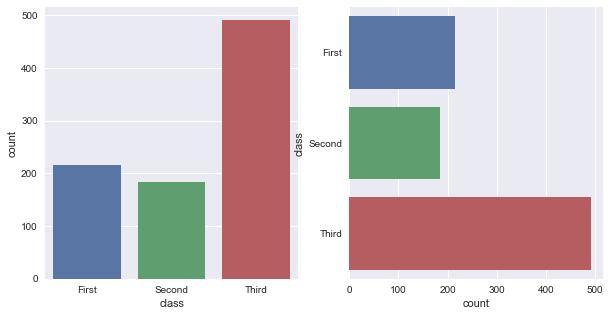在Python数据可视化中,seaborn较好的提供了图形的一些可视化功效。
seaborn官方文档见链接:http://seaborn.pydata.org/api.html
countplot是seaborn库中分类图的一种,作用是使用条形显示每个分箱器中的观察计数。接下来,对seaborn中的countplot方法进行详细的一个讲解,希望可以帮助到刚入门的同行。
- 导入seaborn库
1 import seaborn as sns
- 使用countplot
1 sns.countplot()
countplot方法中必须要x或者y参数,不然就报错。
官方给出的countplot方法及参数:
sns.countplot(x=None, y=None, hue=None, data=None, order=None, hue_order=None, orient=None, color=None, palette=None, saturation=0.75, dodge=True, ax=None, **kwargs)
下面讲解countplot方法中的每一个参数。以泰坦尼克号为例。
原始数据如下:
1 sns.set(style='darkgrid') 2 titanic = sns.load_dataset('titanic') 3 titanic.head()

x, y, hue : names of variables in ``data`` or vector data, optional. Inputs for plotting long-form data. See examples for interpretation.
- 第一种方式
x: x轴上的条形图,以x标签划分统计个数
y: y轴上的条形图,以y标签划分统计个数
hue: 在x或y标签划分的同时,再以hue标签划分统计个数
sns.countplot(x="class", data=titanic)

sns.countplot(y="class", data=titanic)
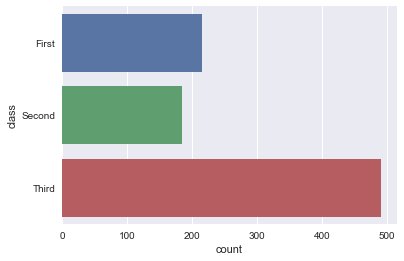
1 sns.countplot(x="class", hue="who", data=titanic)
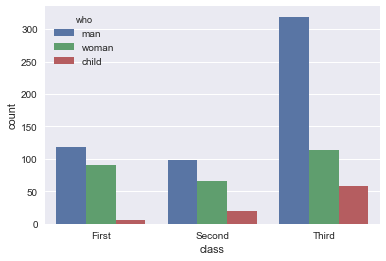
- 第二种方法
x: x轴上的条形图,直接为series数据
y: y轴上的条形图,直接为series数据
sns.countplot(x=titanic['class'])
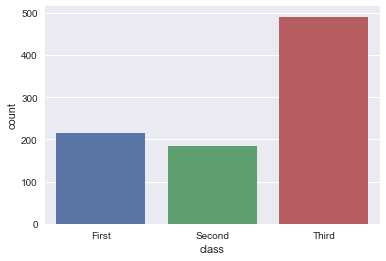
sns.countplot(y=titanic['class'])

data : DataFrame, array, or list of arrays, optional. Dataset for plotting.
If ``x`` and ``y`` are absent, this is interpreted as wide-form. Otherwise it is expected to be long-form.
data: DataFrame或array或array列表,用于绘图的数据集,x或y缺失时,data参数为数据集,同时x或y不可缺少,必须要有其中一个。
1 sns.countplot(x='class', data=titanic)
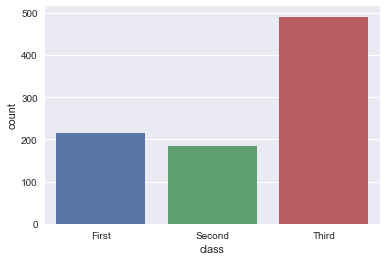
order, hue_order : lists of strings, optional.Order to plot the categorical levels in, otherwise the levels are inferred from the data objects.
order, hue_order分别是对x或y的字段排序,hue的字段排序。排序的方式为列表。
1 sns.countplot(x='class', data=titanic, order=['Third', 'Second', 'First'])

1 sns.countplot(x='class', hue='who', data=titanic, hue_order=['woman', 'man', 'child'])

orient : "v" | "h", optional
Orientation of the plot (vertical or horizontal). This is usually
inferred from the dtype of the input variables, but can be used to
specify when the "categorical" variable is a numeric or when plotting
wide-form data.
强制定向,v:竖直方向;h:水平方向,具体实例未知。
color : matplotlib color, optional
Color for all of the elements, or seed for a gradient palette.
palette : palette name, list, or dict, optional.Colors to use for the different levels of the ``hue`` variable.
Should be something that can be interpreted by :func:`color_palette`, or a dictionary mapping hue levels to matplotlib colors.palette:使用不同的调色板
1 sns.countplot(x="who", data=titanic, palette="Set3")
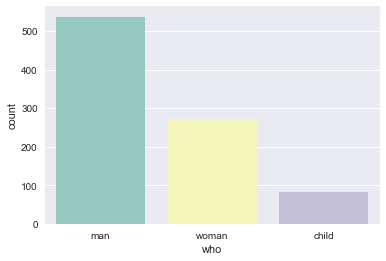
ax : matplotlib Axes, optional
Axes object to draw the plot onto, otherwise uses the current Axes.
ax用来指定坐标系。
1 fig, ax = plt.subplots(1, 2, figsize=(10, 5)) 2 sns.countplot(x='class', data=titanic, ax=ax[0]) 3 sns.countplot(y='class', data=titanic, ax=ax[1])
